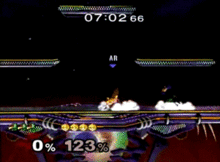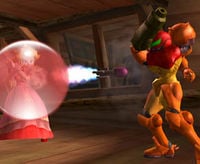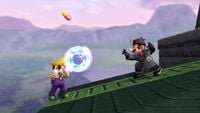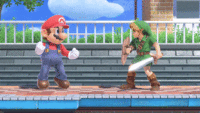| Welcome to SmashWiki! Log in or create an account and join the community, and don't forget to read this first! |
| Notices |
|---|
| SmashWiki will be experiencing a server migration on April 16th, 2025, expected to begin at 7:00 am (EDT) and lasting for up to 12 hours. The wiki may be entirely unavailable during that time. |
Perfect shield
A perfect shield (ジャストシールド, Just shield) (officially called the Power Shield in Melee) is a technique introduced in Melee where one activates a full shield (or drops their shield as of Ultimate) such that it connects with an incoming attack on the first few frames. In order for the technique to be executed, one must rely on timing and skill. When the opponent is ready to strike, the player must quickly use their shield. If done correctly, the character takes no shield damage and they can immediately perform any action when dropping their shield without having to wait for their drop shield animation to end (alternatively known as powershield canceling in games prior to Ultimate). The perfect shield technique in Melee, Brawl, Smash 4, and Ultimate is comparable to a parry in traditional fighting games, as it results in little to no knockback and freezes the opponent for a couple frames.
Perfect shielding up until Smash 4 is done by quickly pressing the shield button as an attack is about to connect (the exact window to perfect shield depends on the game). If done correctly, there will be a significant flash on the shield and a distinctive "chlink" sound. Because it is technically a shield, it is ineffective against grabs and unblockable attacks. In Melee, powershielding can reflect projectiles during the first two frames, although they deal half their usual damage (unlike other reflectors, which increase their damage), and Poké Balls reflected this way retain the ownership of the character that threw them. In Brawl and Smash 4, perfect shielding merely redirects projectiles at an angle without changing their ownership.
In Ultimate the method has been reversed: after a shield has already been raised, perfect shielding is done by releasing the shield button immediately before an attack connects. If performed correctly, the defending character flashes, and both characters (if the attacking character uses a melee attack) enter hitlag, but the defending character is still able to recover much quicker for a counterattack.
CPU players, especially at level 9, use this technique a lot to reflect projectiles in Melee, and against any oncoming attack since Brawl. It is not used super often by human players due to the reaction times and precision usually required, and as such, it often comes as a surprise and players do not always fully take advantage of it. However, it can be an extremely powerful technique when mastered and it is commonly the most optimal counterplay against many attacks (especially from Brawl onwards).
In Super Smash Bros. Melee[edit]
In Melee, the technique is known as power shielding (named for the Power Shielder bonus attained by using the technique multiple times). Powershielding is accomplished by shielding an attack within the first four frames of putting up the shield (2 frames for projectiles). Powershielding removes all shield damage an attack would otherwise incur but powershielding also incurs more shield pushback compared to a full regular shield which can make some attacks harder to punish. Powershielding functions differently depending on whether a physical attack or a projectile is power shielded.
Against physical attacks, the player has a 4 frame window to powershield. If the player successfully powershields, they still receive the same amount of hitlag and shieldstun as a regular shield but they do gain one unique advantage which improves their punishment potential. When the player normally shields an attack, the player has to drop their shield in order to perform most of their ground attacks. This takes 15 frames, creating a long delay between when the player can drop their shield and when they can attack. When an attack is powershielded however, the player can directly cancel their drop shield animation with an attack, only giving them a one frame delay compared to the usual 15 frame delay. This is known as powershield canceling and it gives the player much greater punishment potential. For example, Falco's jab is normally a frame 17 Out of Shield option as it is a frame 2 jab and the player has to wait 15 frames to drop their shield before they can jab. This is rather slow and Falco has faster options he can use. Out of a powershield however, Falco's jab becomes a frame 3 option due to powershield canceling, allowing Falco to punish moves he normally would not be able to. Powershield canceling allows the players to both punish moves they normally cannot punish and punish moves with much stronger punishes than what would normally be possible which can naturally be highly beneficial. A thing to note is that because shieldstun is still the same when powershielding an attack, moves which do not need to be powershield canceled (grabs, up smashes/up specials and aerials) are still the same speed as if an attack was shielded normally.
Against projectiles, powershielding works very differently. The player has only 2 frames to powershield a projectile and powershielding projectiles does not allow the player to powershield cancel. On the flip side, powershielding allows the player to reflect projectiles and whenever a projectile is powershielded, the shielding player suffers from no shieldstun. This makes powershielding a very valuable tool against projectiles as it allows a player to instantly reflect projectiles and the player can act considerably quicker after powershielding a projectile than if they shielded a projectile normally.
Powershielding is a very difficult technique to take full advantage of due to the timing required but mastering it can be very useful. Powershielding is overall very effective against projectiles as it allows players to instantly and quickly reflect projectiles with a low amount of risk. The reflected projectiles can punish the player throwing the projectile and the powershielding opponent can very quickly followup after powershielding a porjectile. A successful powershield is very fast in this scenario and even an unsuccessful powershield still usually does not leave the shielding opponent in a bad spot.
The effectiveness of powershielding regular attacks on the other hand is a bit more varied. While the timing is more lenient than reflecting a projectile on paper and it can lead to more punishes against attacks, it also has the notable downside in that it gives more shield pushback compared to a regular shield. This can prevent normally guaranteed punishes from connecting or at the very least make them more strict which can especially be tricky for low traction characters. Power shielding physical attacks is also rather risky. Shielding too early will result in a normal shield which is often less ideal while shielding too late will naturally result in the player getting hit. In addition to this, powershielding can also be overshadowed by crouch canceling in some situations. Crouch canceling is just as accessible as powershielding but it does not require specific timing and against a variety of attacks, it allows the player to recover faster than if they powershielded the move, giving the player better punishment options. Crouch canceling can even leave the player closer to the opponent compared to powershielding depending on the attack. Crouch canceling is far more attack dependent compared to power shielding and there are definitive instances where power shielding is the better option to punish attacks but there are also instances where crouch canceling is more reliable and more effective compared to power shielding.
Overall, powershielding in Melee has some notable advantages and it can be very useful in some situations but it also has some notable disadvantages and it can be outclassed by crouch canceling in some situations, especially with the higher execution required for powershielding.
One final thing to note about powershielding is that Yoshi's powershield functions quite differently compared to other characters due to his unique shield. During the first two frames of his shield, Yoshi cannot powershield physical attacks. He will instead parry the attacks with his invincible shield startup. Yoshi can reflect projectiles during these first two frames but his powershield to reflect projectiles is very small, often resulting in Yoshi parrying projectiles instead. On frames 3-4 of Yoshi's shield animation, he can powershield attacks if the player attacks him close enough. Yoshi's hurtbox is larger than his powershield bubble though and if Yoshi is hit outside of the bubble, he can parry. Yoshi can uniquely powershield physical attacks at any point while shielding. This is because Yoshi's powershield bubble remains active once Yoshi's shield is fully active and it extends slightly further than his regular shield in areas, allowing opponents to hit Yoshi's constantly active powershield if they hit him at certain ranges/angles.[1].
Yoshi's powershield does have a rather significant disadvantage in that Yoshi is the only character who cannot powershield cancel. This is especially bad for Yoshi as he cannot jump Out of Shield and his shield grab is extremely slow. Yoshi also often cannot reflect projectiles with his powershield as his powershield for projectiles is so small that in most scenarios, Yoshi will simply parry projectiles. In general, Yoshi's parry completely overshadows his powershield as it allows Yoshi to punish Out of Shield faster (as Yoshi skips hitlag when parrying) and it allows Yoshi to jump Out of Shield which he normally cannot do, allowing for much greater punishment and movement than Yoshi would get out of a powershield.
In Super Smash Bros. Brawl[edit]
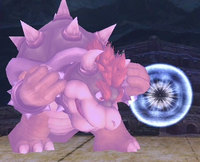
The ability to powershield returns in Brawl, now officially known as a perfect shield (although the technique was still colloquially referred to as a powershield). Perfect shielding is executed in the same way as Melee although the window to perfect shield an attack has been reduced to 3 frames, making the technique even more precise. While the execution is largely the same, perfect shield has received numerous changes, many of which make it more effective than in Melee.
Powershield once again removes all shield damage but one of the biggest and most valuable changes is that instead of increasing shield pushback, powershield now reduces shield pushback by 0.15x, essentially giving attacks virtually no shield pushback. This eliminates the one disadvantage powershielding had over regular shielding in Melee, making powershielding purely advantageous over regular shielding in Brawl. When combined with shield SDI, players could even advance forward when powershielding although this is extremely technical to perform.
When powershielding an attack, the shielding player once again goes through the same hitlag and shieldstun as if they shielded a move normally and they once again gain access to powershield canceling once they drop their shield. Powershield canceling has the same benefits as Melee (albeit to a lesser extent compared to regular shield due to the drop shield animation being sped up to 7 frames) but powershield canceling itself has seen a positive change. In Melee, the player had a one frame delay before they could perform a powershield canceled attack but in Brawl, this one frame of delay has been removed, allowing the player instant access to their entire moveset. This speeds up powershield canceled punishes even further, allowing for more punishment opportunities.
The player is capable of buffering their desired powershield cancel punish to punish as soon as possible but in order to do so, the player has to let go of shield during shieldstun. The player can buffer their attack during the universal 10 frame buffer window but they have to let go of shield during shieldstun in order for the buffered input to go through. Letting go of shield too early will result in the buffered input not going through and letting go too late will naturally result in the player keeping their shield up. Due to Brawl's low or even non existent shieldstun depending on the attack used, this means that buffering a powershield cancel punish is very strict despite the game's otherwise generous buffer window. A powershield cancel forward smash and down smash also have to be buffered in order to be performed on the first possible frame. If the player tries to manually forward/down smash powershield cancel on the first possible frame, the player will roll or spot dodge respectively. These options can be done manually but without buffering, they have to be delayed in order to avoid rolling/spot dodging. Once again, as powershielding does not reduce shieldstun, non powershield canceled punishes are still the same speed as they would be when shielding regularly (grabs, up smashes/up specials and aerials).
Perfect shielding projectiles has also significantly changed. One significant change is that perfect shielding no longer reflects projectiles; should a projectile connect during perfect shield frames, it will either disappear or rebound off the shield at an angle instead of back in the direction it came from. A projectile that bounces off a character's shield can no longer affect that character unless it is a multi-hit attack. Powershield also no longer removes shieldstun from projectiles with the player going through the same shieldstun as if they shielded a projectile normally. This overall makes powershielding a less powerful option against projectiles, especially in comparison to regularly shielding. However, the window to powershield projectiles has been increased to 3 frames and the player can now powershield cancel after powershielding a projectile, giving the player better punishment opportunities against close range projectiles in particular.
Overall, powershielding has become even more potent against physical attacks due to shield pushback being completely minimised, removing the main disadvantage powershielding had compared to Melee. This combined with the universally reduced shieldstun, the remove of L-canceling and with crouch canceling becoming almost entirely worthless has made powershielding one of the most powerful techniques in the game. It is almost always the optimal way to deal with attacks and while it remains an extremely difficult technique to take full advantage of, mastering the technique has become more potent than ever. Powershielding projectiles has lost some notable utility with the loss of reflecting projectiles but powershielding projectiles still remains advantageous due to the removed shield damage, shield pushback and the ability to powershield cancel.
Yoshi's perfect shield is once again an anomaly compared to the rest of the cast but not in a positive way. Yoshi's powershield window is now the same as every other character with Yoshi only being able to powershield attacks during the first 3 frames of putting up his shield. Yoshi is no longer invincible during his shield's startup and his powershield still remains considerably smaller than his body so if the opponent hits Yoshi's head while his powershield is up, Yoshi will get hit by the attack, completely removing Yoshi's parry and leaving Yoshi vulnerable when putting up his shield. When Yoshi powershields an attack, he is still incapable of powershield canceling which is once again massively detrimental to Yoshi due to his extremely slow shield grab, his inability to jump Out of Shield and with his drop shield animation being significantly longer than any other character (and unlike Melee, Yoshi does not have a parry to offset this). As a result, Yoshi's powershield is far and away the worst out of the entire cast in Brawl and while it is still beneficial to him due to the removed shield damage and shieldstun, it is far less beneficial to him than any other character due to his inability to powershield cancel and his overall extremely poor Out of Shield options.
In Super Smash Bros. 4[edit]
In Smash 4, perfect shielding is executed in the same way as Brawl with the player having to shield an attack within the first 3 frames of putting up their shield. Perfect shield once again removes shield damage, removes almost all shield pushback and it grants the player access to powershield canceling. Powershield canceling mostly functions in the same way as it did in Brawl although it has become significantly simpler to buffer powershield canceled options with the player no longer needing to let go of shield during shieldstun. This makes it significantly easier and more lenient to buffer powershield cancel punishes, making it easier for the player to utilise powershield canceling as quickly as possible.
Perfect shielding has received an additional benefit compared to regular shielding in that the shieldstun formula now has a 0.66x multiplier for powershielded attacks, resulting in a vast majority of powershielded attacks having less shieldstun compared to regular shielding. This naturally means that when an attack is powershielded, the shielding player has more time to punish not just with powershield canceling but even with non powershield canceled options.
Prior to update 1.1.1, perfect shielding's input window was increased to 4 frames (much like physical attacks in Melee), making perfect shielding more lenient. Perfect shielding also did not decrease shieldstun although due to the universally lower shieldstun, powershielding still resulted in less shieldstun than later versions, making it more effective against a vast majority of attacks. These differences overall made perfect shields more lenient and effective in earlier versions of the game. As of update 1.1.1, the window to powershield was reduced back down to 3 frames in addition to powershielding now reducing shieldstun.
Overall, perfect shielding has become more effective than in Brawl on paper with powershield cancels becoming easier to perform with their more generous buffer window and with perfect shield reducing shieldstun although in practice, powershielding is less effective due to the universally increased shieldstun compared to Brawl. Despite this, it still remains one of the most powerful techniques in the game being hard yet rewarding to master.
Yoshi's perfect shield now functions like every other character with Yoshi being able to powershield cancel. This is naturally a large benefit to Yoshi as it greatly improves Yoshi's ability to punish attacks Out of Shield, especially since he can now jump Out of Shield and his drop shield animation was normalised to match the rest of the cast. Ryu has a unique property with his perfect shield, as his perfect shield has a unique sound effect based on the parry in Street Fighter III: 3rd Strike.
One final note is that certain equipment has special effects for perfect shields. The Easy Perfect Shield effect widens the window for performing a perfect shield, while the Explosive Perfect Shield effect causes them to create a small, damaging explosion.
In Super Smash Bros. Ultimate[edit]
Perfect shielding in Super Smash Bros. Ultimate functions completely differently than in previous games. It now requires the player to release the shield button when an attack connects against their shield, instead of the other way around. It is also significantly more dramatic upon activation: it creates a much brighter flash from the perfect shielder, causes their eyes to glow yellow, and they perform a unique animation while the sound effect produced is louder like in Brawl. Ryu keeps his unique sound effect and now shares it with Ken. Due to these properties, the perfect shield in Ultimate is usually referred to as a parry by the Smash community.
Perfect shielding is activated during the first 5 frames of a character's shield drop animation, which lasts 11 frames (up from Smash 4's 7 frames). The shield has to be put up for at least 3 frames before it can be dropped, essentially causing the technique's earliest possible activation to be 4 frames upon shielding. As a result, while it has a larger window, it can no longer be done immediately, and is less likely to be activated unintentionally, thus carrying more risk. However, unlike in previous games, the radius of a perfect shield does not shrink in proportion to the character's shield, and instead always matches the size of a full shield, increasing its consistency.
Perfect shielding gives different amounts of extra hitlag to the attacker and defender, with intangibility for the defender. Depending on whether a perfect shielded attack is a projectile, and direct or indirect (determined by the attack's hitbox scripts), it has several outcomes:
- For direct non-projectile attacks, the attacker experiences 14 extra frames of hitlag, while the defender experiences 11 extra frames. As a result, the defender can act 3 frames earlier than shielding the attack normally. Although this difference in itself is minimal, perfect shielding still lets the user bypass shield drop lag with any attack like in previous games (compared to only aerial attacks, up smash, and up special), which is a more valuable attribute in Ultimate due to it having been increased, making perfect shielding much more advantageous for punishing usual direct attacks than shielding normally.
- For indirect non-projectile attacks (such as Zero Suit Samus's down smash, Mii Gunner's back aerial, and Bayonetta's smash attacks), the attacker experiences 14 extra frames of hitlag, and the defender experiences only 2 frames more. This allows the defender to act 12 frames earlier than shielding it normally, leaving these moves even more punishable by perfect shielding.
- For direct projectile attacks (such as Isabelle and Snake's up smashes), the attacker is not affected, while the defender experiences 8 extra frames of hitlag. This causes the user to act 8 frames later by comparison, making perfect shielding strictly worse for punishing these attacks than normal shielding.
- For indirect projectile attacks (usual projectiles), the attacker is not affected, while the defender experiences 1 frame less of hitlag. As a result, like with direct attacks, perfect shielding traditional projectiles offers an advantage over shielding them normally, albeit not as significant.
Prior to update 9.0.0, perfect shielding's advantage against both direct and indirect projectiles was 3 frames lower, so that the user could act 11 and 2 frames later (respectively) than shielding them normally, making it less effective against camping. Although update 3.0.0 allegedly increased these advantages to match the current versions, which was (vaguely) documented on Nintendo's official patch notes, it was discovered nearly a year after the update that these changes only applied to Training mode, and were thus irrelevant in competitive play; it was not until 9.0.0 that they applied to every game mode.
With perfect shielding now being tied to the shield drop animation, certain limits have been implemented to it. If an attack is shielded normally, perfect shielding is disabled on a subsequent shield drop unless it is done at least 3 frames after shieldstun ends, preventing characters from easily perfect shielding multi-hit moves that do not possess enough shieldstun to keep opponents trapped inbetween their hits. Similarly, from version 3.0.0 onward, multiple perfect shields cannot occur within the same shield drop. An exception is if the first hit of a move with multiple hits separated by only one frame is perfect shielded on the first shield drop frame, which causes the next hit to automatically be perfect shielded as well; an example of a move that can trigger this is Wolf's forward tilt.
Much like equipment in Smash 4, certain spirit effects can affect perfect shields: the returning Easy Perfect Shield effect widens the window for performing a perfect shield, while the Perfect Shield Reflect effect allows them to reflect projectiles, similar to how they worked in Melee.
Trivia[edit]
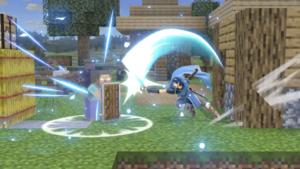
- In the EarthBound series there exists an ability known as Power Shield that can be used by using the PSI techniques PowerShield (in EarthBound Beginnings) and Shield and PSI Shields β or Ω (in EarthBound). Their function is to reflect attacks back to the owner, similar to how powershielding in Melee reflects projectiles.
- When performing a successful parry in Ultimate, the performer's portrait briefly shows the eye glint used in the pre-match splash screen. Additionally, the parrying fighter's eyes will glow, the same effect which occurs when a fighter is ready to use a Final Smash.
- Some fighters' perfect shields reference their original games aesthetically:
- Kirby's parry animation is taken from his Guard pose in Kirby Super Star.
- Wario's parry animation resembles both his official artwork from Super Mario Land 2 and a render from Wario World.
- Ryu and Ken's parry animations and their accompanying sound effect are taken from Street Fighter III: 3rd Strike.
- Dark Samus' parry animation references official artwork from Metroid Prime 3: Corruption.
- Banjo strikes a pose similar to the pose the Extra Lives depict him in, as well as an idle animation he can perform in Banjo-Kazooie: Nuts & Bolts.
- Terry's parry animation is his Just Defense Pose from Garou: Mark of the Wolves
- Steve uses a Shield from Minecraft to block the attack.
- Sora's parry animation is the pose he makes while using Guard in Kingdom Hearts.
- If the Shadow Assist Trophy freezes a character during the perfect shield window, the character will automatically perfect shield an attack while frozen. The character will even remain intangible afterwards until being unfrozen.
